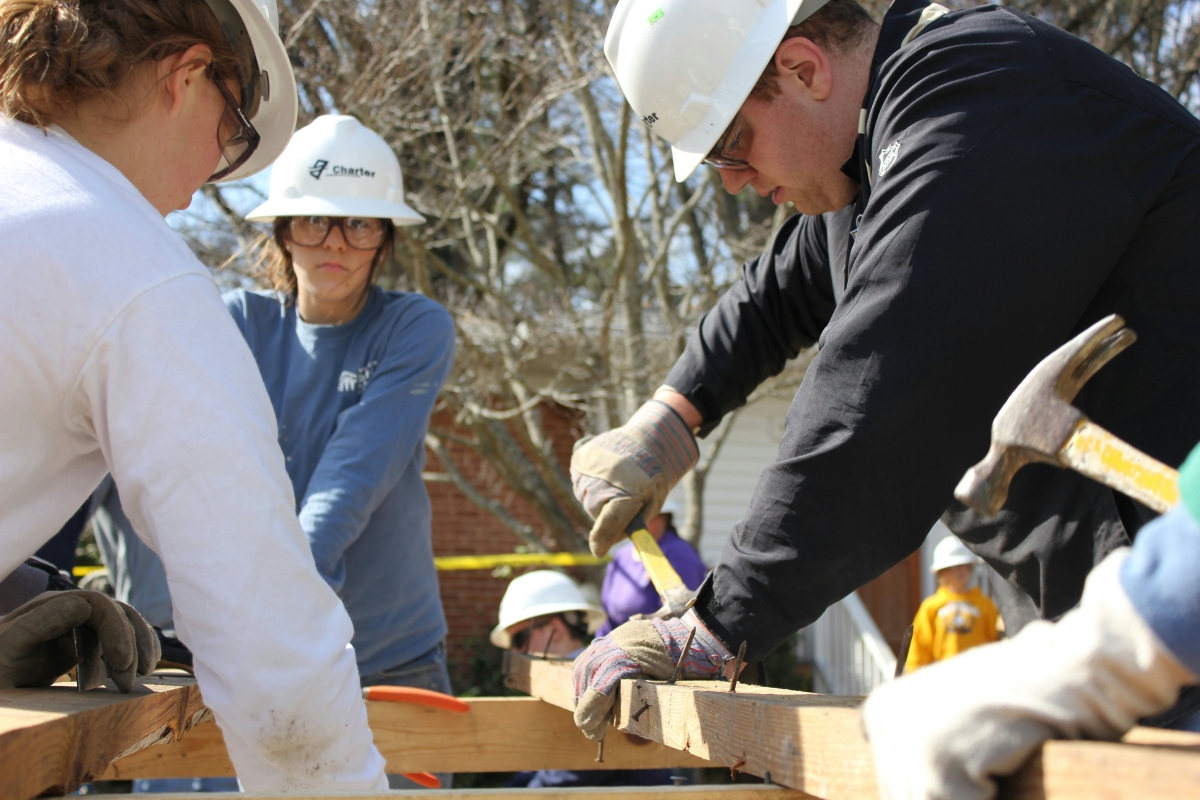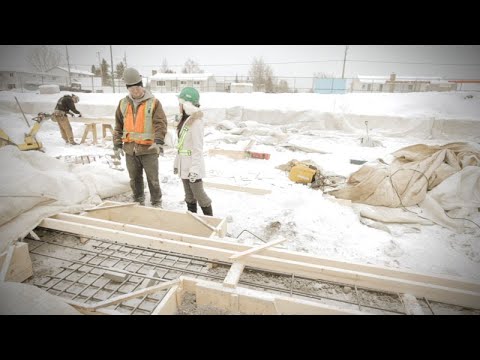Career Overview
Carpenters build, install, maintain, repair and renovate homes and structures made of wood, lightweight steel and other materials. Carpenters must work precisely and make accurate calculations. They should also be able to imagine what a finished project will look like from plans.
Job Titles
Duties
Carpenters:
- Study blueprints, drawings and sketches to determine specifications
- Calculate the amount and type of materials needed
- Use measuring tools to prepare layouts
- Ensure layouts meet building codes
- Measure, cut, shape, assemble and join materials
- Build foundations, install floor beams, lay sub-flooring and put up walls and roof systems
- Build footings and moulds for concrete
- Fit and install doors, stairs, moulding and hardware
- Supervise apprentices and other construction workers
- May prepare cost estimates for clients
Earnings
Earnings is income that workers receive in exchange for their labour. Depending on the type of employment, earnings can be in the form of wages (hourly), salaries (fixed monthly or annual) or self-employed earnings.
Work Environment
# Workers Employed
27,210% Employed Full Time
51%Carpenters work for construction companies, carpentry contractors and the maintenance departments of factories and other businesses. Some are self-employed.
The work offers many options. Some carpenters frame or finish houses. Some do repairs after fire or water damage. Others work with concrete on commercial projects.
Carpenters usually work 40 hours per week, sometimes more to meet deadlines. In many areas of the province, work can be seasonal. Outside of the Mainland/Southwest and Vancouver Island/Coast regions, carpenters have less work in the winter and work longer hours in the summer.
Carpenters work alone or in teams, both indoors and outdoors. The work is often noisy and dirty. It requires lifting, working from heights and using tools and equipment, so safety precautions are important.
Career Pathways
Most carpenters begin their careers by working as apprentices or as construction labourers.
With experience and additional training, some move into supervisory positions, such as foreperson or construction superintendent. Others become self-employed contractors or sub-contractors.
Occupational Interests
It’s important to understand what kinds of occupations align with your interests.
For more about occupational interests visit Skills for the Future Workforce > Characteristics.
Here are the top occupational interest(s) for this career profile:
Education, Training and Skills
Most jobs require a high school diploma. Workers can also take introductory four-to-10-month training programs that prepare them for entry-level carpentry positions.
Certification is not required to work as a carpenter in B.C. Those who wish to be certified must complete a four-year apprenticeship program.
Apprenticeship programs
Work experience and in-class instruction are part of apprenticeship programs. Some part-time and online programs may be available. To apprentice, workers must be sponsored by an employer. A person who successfully completes an apprenticeship program and the final certification exam earns a Certificate of Qualification. Workers with significant experience in the trade may be able to challenge the certification exam to earn the Certificate of Qualification without completing a formal apprenticeship. For more information on earning a Certificate of Qualification, visit SkilledTradesBC.
To work in other provinces
Carpenters may need Red Seal certification to work in other provinces. This can be earned by passing an exam and proving significant work experience.
Workers coming to B.C.
Carpenters who are certified by a regulator elsewhere in Canada can apply for the same certification from the regulator in B.C. Under the terms of the Canadian Free Trade Agreement (CFTA), most applicants who are transferring their credentials from elsewhere in Canada will not be required to complete additional training or testing. However, the B.C. regulator may ask applicants to provide further information, such as a letter of good standing, references or a criminal record check.
Workers who trained outside of Canada
Carpenters who trained outside of Canada and have never received certification from a Canadian jurisdiction will likely need a full assessment. Most occupational regulators have a process for assessment and recognize internationally trained applicants. Contact SkilledTradesBC for details on how to apply for certification in B.C.
For information about labour mobility in Canada, visit www.workersmobility.ca.
View a list of Professional Regulatory Authorities in B.C.
Education programs in B.C.

Top Skills
Every job calls for a certain set of skills. Knowing those skills is the first step in finding a good career fit.
Here, you will find the 10 most relevant workplace skills. Some are more important to achieving success in a certain career than others. These skills may come naturally to you or you may need to gain them through education, training and experience.
See the list of work-related skills below, ranked in order of importance for this career. Check out the list and see if this career matches your skills—take that first step!
Using logic and reasoning to identify the strengths and weaknesses of alternative solutions, conclusions or approaches to problems.
Keeping track of and assessing your performance, other individuals, or organizations to make improvements or take corrective action.
Giving full attention to what other people are saying, taking time to understand the points being made, asking questions as appropriate, and not interrupting at inappropriate times.
Adjusting actions in relation to others' actions.
Conducting tests and inspections of products, services or processes to evaluate quality or performance.
Understanding written sentences and paragraphs in work-related documents.
Talking to others to share information effectively.
Using mathematics to solve problems.
Understanding how new information could be used to solve current and future problems in making decisions.
Being able to solve novel, ill-defined problems in complex, real-world settings.
Labour Market Statistics
Discover data, facts and information that have been gathered and analyzed. Learn about the characteristics of the economy and labour market in B.C.
Employment
Find out about employment types and trends by region and industry.
Employment
27,210Employment by Region







| Region | Employment | % Employment of this Occupation |
|---|---|---|
| Cariboo | 955 | 3.5% |
| Kootenay | 1,355 | 5.0% |
| Mainland/Southwest | 13,975 | 51.4% |
| North Coast and Nechako | 625 | 2.3% |
| Northeast | 325 | 1.2% |
| Thompson-Okanagan | 3,860 | 14.2% |
| Vancouver Island/Coast | 6,115 | 22.5% |
Labour Market Outlook
The B.C. Labour Market Outlook is a 10-year forecast of the expected supply and demand for labour in the province. It’s usually updated every year. The purpose is to provide British Columbians with the knowledge to make informed decisions on careers, skills training, education and hiring.
Forecasted Job Openings (2025-2035)
10,420Forecasted Job Openings
Forecasted Employment Growth Rate
Composition of Job Openings
Job Openings by Region (2025-2035)







| Region | Job Openings | Avg. Annual Employment Growth |
|---|---|---|
| Cariboo | 330 | 0.3% |
| Kootenay | 450 | 0.2% |
| Mainland/Southwest | 6,210 | 1.5% |
| North Coast and Nechako | 310 | 0.6% |
| Northeast | 120 | -0.1% |
| Thompson-Okanagan | 1,120 | 0.1% |
| Vancouver Island/Coast | 1,890 | 0.5% |
Industry Highlights
Learn about the opportunities in B.C.'s major industries, including employment trends, earning potential, locations of work and more.
Forecasted Job Openings by Industry
| Industry | Job Openings (2025-2035) |
|---|---|
| Construction | 9,260 |
| Manufacturing | 200 |
| Information, Culture and Recreation | 140 |
| Public Administration | 110 |
| Business, Building and Other Support Services | 100 |
Insights from Industry
Demand for carpenters relies on growth in the construction industry and any future slowdown will reduce job openings. Certified carpenters and those with experience have an advantage in finding work.
Seeing the final product of a project can make carpentry a very rewarding career.
Resources
-
Architectural Woodwork Manufacturers Association (AWMAC), B.C. Chapterbc.awmac.com
-
British Columbia Construction Association (BCCA)www.bccassn.com
-
British Columbia Regional Council of Carpenters (BCRCC)bcrcc.ca
-
BuildForce Canadawww.buildforce.ca/en
-
Canadian Home Builders' Association of British Columbia (CHBA BC) - Continuing Educationeducation.chbabc.org/home.php
-
Careers in Constructionwww.careersinconstruction.ca
-
Construction Industry Training Network (CITN)trainingnetwork.ca
-
Construction Labour Relations Association (CLR) of BCwww.clra-bc.com
-
Construction Maintenance and Allied Workers Canadawww.cmaw.ca
-
Homebuilders Association Vancouver (HAVAN)havan.ca
-
Independent Contractors and Businesses Association (ICBA)www.icba.ca
-
Red Seal Programwww.red-seal.ca/eng/welcome.shtml
-
Skilled Trades Employment Program (STEP)www.stepbc.ca
-
SkilledTradesBCskilledtradesbc.ca/
-
Vancouver Regional Construction Association (VRCA)vrca.ca








